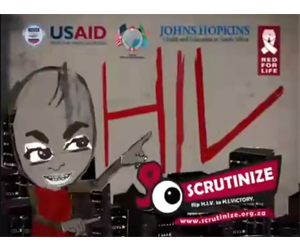Young people across South Africa are scrutinizing their behaviors and taking action to reduce their risk of HIV infection, an evaluation of the award-winning, innovative Scrutinize campaign has found.
The comprehensive evaluation of the first year of Scrutinize (June 2008 to July 2009), was undertaken by Dr. Larry Kincaid, a faculty member in the Research and Evaluation Division at the Center for Communication Programs. The evaluation is based on data from the 2009 National Communication Survey that comprised 9,728 respondents from across nine provinces that aimed to measure the impact of communication programs in South Africa.
The evaluation found that the campaign has been effective in breaking through the media clutter and that the use of animation was effective in grabbing the attention of young South Africans. Seventy nine percent (79%) of youth aged 16-24, 73% of young people aged 25-35 and 55% of adults aged 36-55 recognized the Scrutinize TV campaign and logo. The evaluation found that the campaign was cost effective, costing only $0.14 per person reached.
A nine-item scale was developed to determine whether there was a dose response between those with higher levels of exposure and those with lower levels of exposure. The nine-item scale included correct recall of the Scrutinize logo; the HIV ninja character; correct meaning for three of the Scrutinize spots tested in the National Communication Survey and the ability to complete the Scrutinize slogans, including pay-off lines in two of the animerts (animated advertisements).
Persons able to recall all nine items of the Scrutinize campaign are considered to have a high degree of exposure, while a low degree of exposure relates to those who were unable to recall any of the nine items correctly – although they may have been exposed to the campaign. Exposure was controlled against 11 socio-economic and demographic factors and other communication programs so as to measure the specific impact of Scrutinize.
The evaluation found that young people with a higher degree of exposure to Scrutinize (able to recall all nine items) had higher levels of knowledge of the behaviors that place them at risk of HIV infection and were more likely to take action to reduce their infection.
Impact on Partner Reduction
In relation to knowledge levels of the risks of multiple sexual partners for HIV infection, only 41% of young men with low levels of exposure knew that multiple partners were a risk factor for HIV infection compared to 54% of young men that were able to recall all nine items – a 13 percentage point difference. Amongst young women there was a 10 percentage point difference – 41% with low exposure compared to 51% of young women able to recall all nine items.
The animert communicating around the risk of HIV infection in the first six weeks after infection was found to be effective in relation to partner reduction particularly with young males. The study found that 111,886 young people that were exposed and could correctly interpret this animert reduced their number of sexual partners. The number of young men who reported reducing their number of partners is significant as the NCS found that 30% of young males reported having multiple partners which increases their risk of HIV infection. The cost per person who reported having fewer partners as a result of exposure to this animert was $2.07.
The evaluation found that there may be a boomerang effect on attitudes relating to multiple sexual partners among young men who think they are not at risk, even though they have multiple partners. In this instance showing entertaining animerts on television may have inadvertently legitimized and reinforced MSP attitudes among a small subset of young men who already hold those attitudes and those who think they are not at risk. The next NCS (2012) will be used to check whether this is indeed the case or not or whether the strategic placement of the animerts reached men already had attitudes favorable to MSP.
Impact on Condom Usage
Young people with a higher degree of exposure to Scrutinize were more likely to use condoms than those not exposed to Scrutinize. This was particularly true for young men. It is estimated that across the entire population (16-55 years of age), an additional 761,483 condom users could be attributed to the Scrutinize campaign. The term additional condom users, includes young people having sex for the first time, people who again take up condom usage after they may have stopped and those who had never used condoms before. The total cost per additional condom user is $7.08 per additional condom user.
Impact on Counseling and Testing
One of the unexpected impacts of Scrutinize has been on counseling and testing. The evaluation found that 53% of all young people with a high level of exposure to Scrutinizehad discussed HIV testing with their friends compared to 35% with no exposure – an 18 point spread difference; 42% of those with high levels of exposure had asked their partners to get tested compared to 33% of those with no exposure – a 9 point difference; 43% of those with high levels of disclosure had disclosed their HIV status to their partners compared to 31% with no exposure.
“This evaluation shows that not only has Scrutinize contributed significantly to increased knowledge about the behaviors that place young people at risk of HIV infection but it also has had a positive effect in getting young people to reduce their number of sexual partners, use condoms and know their HIV status”, says Richard Delate, Country Program Director for Johns Hopkins Health and Education in South Africa (JHHESA).
“The behavioral impact of Scrutinize demonstrates that the mass media can be effective in addressing the behaviours that place people at risk of new infections”, Delate says. “Each additional condom user or person reducing their numbers of partners represents a potential infection prevented or delayed, saving the country millions in potential treatment costs. This study shows that prevention provides the population with the reason to test – by getting people to know what places them at risk of HIV infection drives people to also know their status. Each person who tests positive is a potential new candidate for treatment – therefore prevention is a critical to drive people to testing and subsequently to treatment”.
Debbie Gebhardt, marketing director for Levi’s South Africa, comments that the idea that “doing good is good for business” has been a cornerstone of Levi Strauss & Co’s philosophy for the past 150 years.
“Scrutinize is a brilliant result of powerful public/private partnerships in action. When public/private collaborations start with both parties benefiting from the expertise of each other, 1+1 can equal 3.”
Scrutinize is a collaborative effort between JHHESA, Matchboxology, DramAidE and Levi’s Strauss through its Red for Life initiative, with funding from USAID and PEPFAR, and supported by the two national broadcasters, SABC and e.tv. Scrutinize uses an entertainment education approach that combines mass media (television advertising) with interpersonal communication strategies (with youth in school, out of school and tertiary institutions) to bring about social and behavioral change.
Visit the Scrutinize website to view the animerts learn more about the campaign.
View the Scrutinize presentations on condom use, humor and partner reduction from the South Africa AIDS Conference 2011 and learn more about JHHESA.





